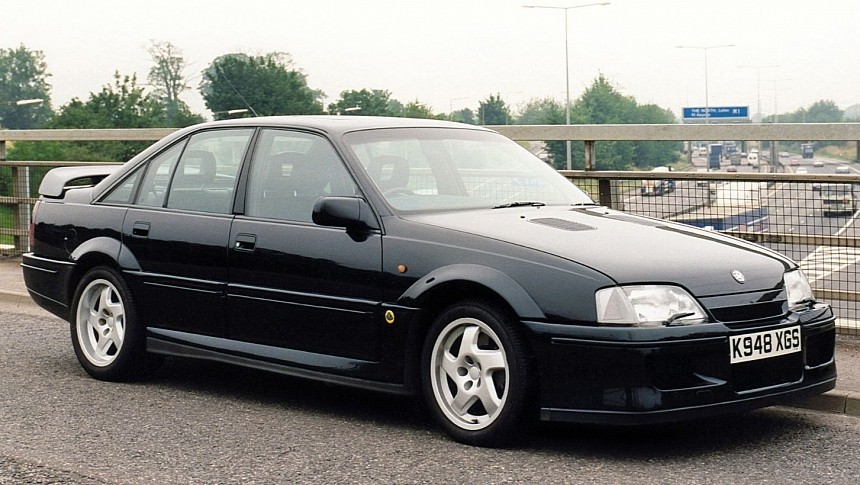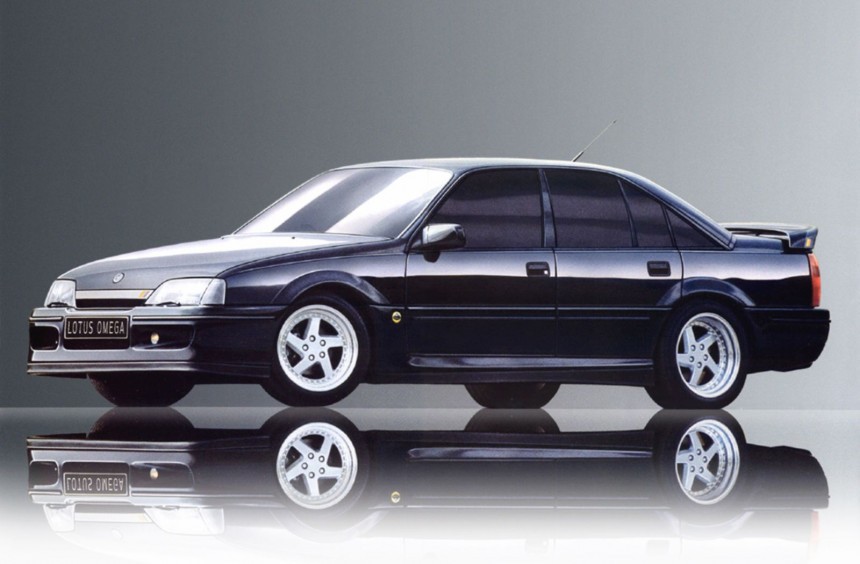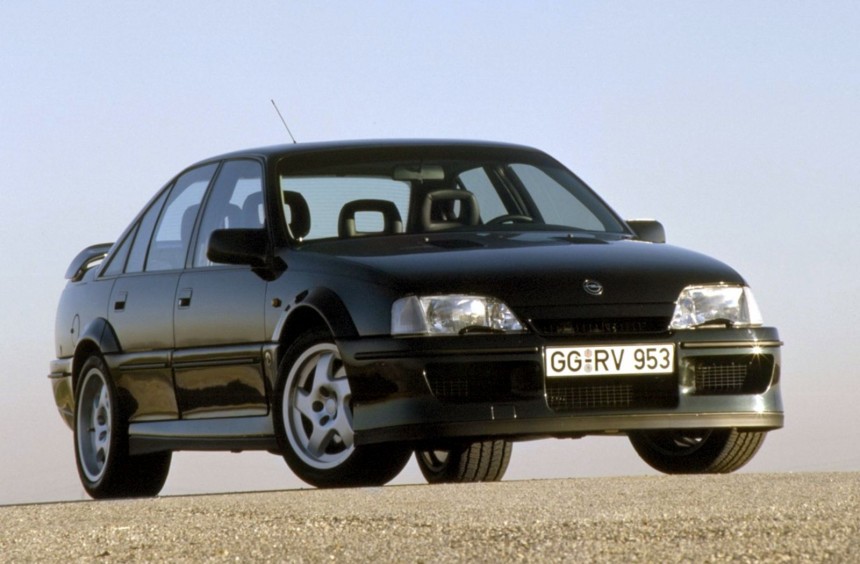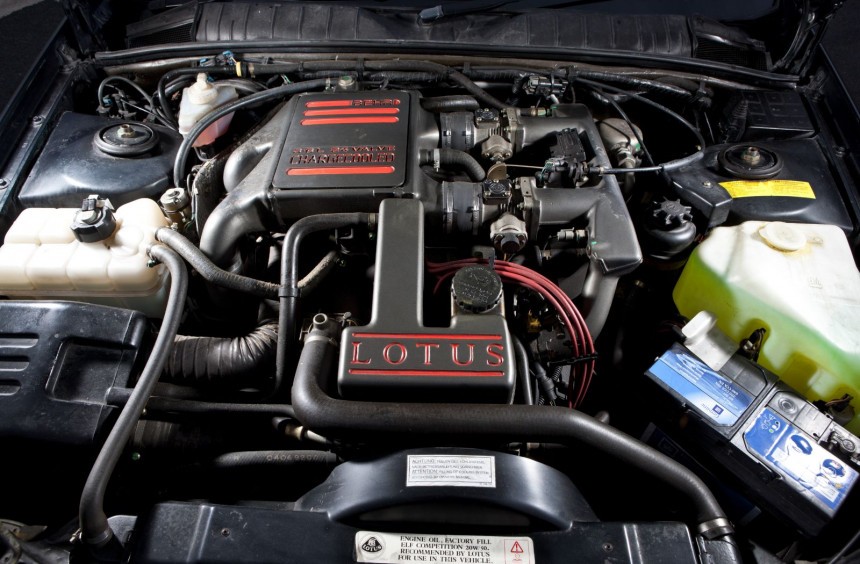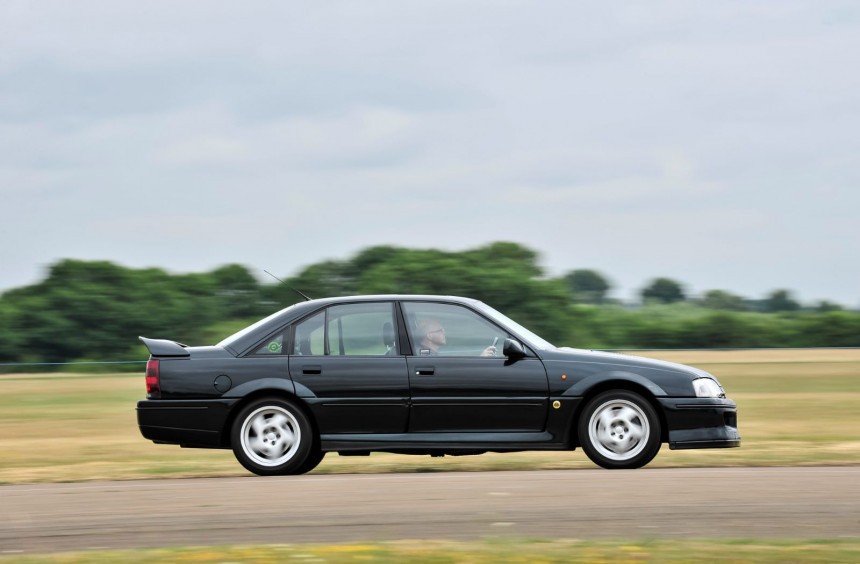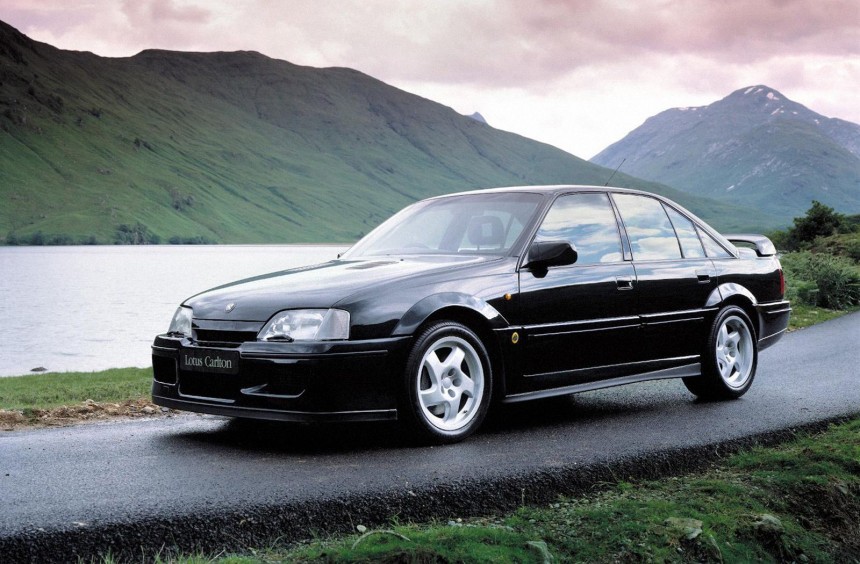Throughout its history, Lotus earned a spot among automotive icons for building some of the best-handling sports cars of all time. But, back in 1990, the company broke with tradition and helped develop one of the fastest sedans that the world had ever seen.
It all started in 1986 when GM’s European division, Opel, introduced a successor for its aging Rekord lineup. Marketed in the UK as Vauxhall Carlton and available as a sedan or wagon, it was conceived as a cheaper alternative to the BMW 5 Series or Mercedes-Benz E-Class.
Though it looked rather uninspiring, the Carlton/Omega was one of the most aerodynamically-efficient cars in the world, boasting a drag coefficient of 0.28. This made the car fuel-efficient, allowing it to reach impressive top speeds using modest engines. For example, the standard straight-four was rated at only 82 hp (83 PS), but thanks to the aerodynamics, the sedan could easily reach 110 mph (177 kph), which was impressive more than three decades ago.
Although the Carlton/Omega was voted European Car of the Year in 1987 and sold well right from the get-go, the Opel and Vauxhall brands had a reputation for creating boring cars powered by ancient engines like twenty-year-old, cam-in-head range.
In 1988, Robert James "Bob" Eaton was named president of GM Europe. Since he was a car enthusiast, first and foremost, one of Eaton's first decisions was to inject some excitement into the corporation's European brands.
Back then, GM owned 91% of Lotus, the renowned car manufacturer and engineering consulting firm. Apart from commissioning the Britons to help develop the state-of-the-art LT5 V8 for the upcoming Corvette ZR-1, Eaton also asked the Hethel-based company to create the fastest high-performance sedan in the world using an existing Opel/ Vauxhall model.
The project started in 1988 using the Opel/ Vauxhall Senator as the building block. This model was actually an upscale, long-wheelbase version of the Carlton/Omega, but with styling that only appealed to senior citizens.
The idea was to squeeze in the ZR-1's V8, tune the suspension, and add a body kit. Unfortunately, the Senator's engine bay proved too small to accommodate the LT5 without extensive modifications. Since Eaton wanted to unveil the high-performance sedan alongside the ZR-1 at the 1989 Geneva Motor Show, there wasn't enough time for such modifications, so the idea was scrapped, and Lotus began experimenting with beefed-up versions of the Opel inline-six.
While Lotus was progressing with a 3.6-liter version of the venerable inline-six, the marketing department realized that a high-performance Senator would eventually cost too much. Combined with the model's lack of appeal, they concluded that such a halo model would fail spectacularly in terms of sales.
Therefore, with just six weeks left until the Geneva motor show, the entire project switched to the conventional-wheelbase Omega/Carlton, which was cheaper and more appealing, especially since the sporty Omega 3000 and Carlton GSi 3000 were already roaming the streets.
With the sedan’s aerodynamically-efficient body and excellent multi-link suspension system, which both owners and the automotive press praised, Lotus engineers were able to put together a high-performance version in just six weeks. They tuned the suspension to cope with higher speeds, added the rear self-leveling and Servotronic power steering systems from the Senator, fitted AP brake calipers that hugged bigger discs, and added some subtle exterior features like wider wheel arches, new bumpers, and a rear spoiler.
But, unquestionably, the most outrageous addition that the high-performance Carlton/Omega received was tucked away under its vented hood.
Based on the 3.0-liter, naturally-aspirated unit that powered the Omega 3000 and Carlton GSi 3000, the engine received a reinforced block enlarged to 3.6 liters, a new forged crankshaft, Mahle forged slipper pistons, and equally beefy, Lotus-engineered conrods. The 24-valve cylinder head, which had just been introduced on the aforementioned sports versions of the sedan, was mostly stock, with only the combustion chambers being mailed to reduce the compression ratio from 10.0:1 to 8.2:1.
The final, most impressive upgrade was not one but two Garrett T25 turbochargers capable of delivering up to 10 psi (0.7 bar) of boost from as low as 1,500 rpm.
Thus, the twin-turbocharged unit could spit out 377 hp (382 PS), two more than the C4 ZR-1’s LT5. Even more impressive, it produced 419 lb-ft (568 Nm) of torque, 50 lb-ft (68 Nm) more than the King of the Hill's V8. All that power was directed to the rear wheels through the same ZF S6-40 six-speed manual available in the ZR-1 and limited-slip differential borrowed from Australia's V8-powered Holden Commodore SS.
This insane engine enabled the Lotus Carlton/Omega to sprint from 0 to 60 mph (97 kph) in 5.2 seconds and reach a top speed of 177 mph (285 kph). It was faster and more powerful than the BMW E34 M5, while the only high-performance sedan that could reach a higher top speed at the time was the sensibly more expensive Alpina B10 Bi-Turbo.
Since I brought up the M5 and B10, the LHD Lotus Omega was homologated in Germany with a top speed of 182 mph (293 kph). If we consider this figure, it was undisputedly the fastest sedan in the world at the time of its introduction since the B10 Bi-Turbo could only reach 179.2 mph (288.4 kph).
Actual top speed aside, the Lotus Carlton/Omega was on par in terms of performance with the Ferrari Testarossa or Lamborghini Countach and could mop the floor with almost any sports car in the same price range.
But, while nobody had any problems with a sports car that could go over 170 mph (273 kph), a surprising number of UK citizens were outraged by the top speed that this sedan could reach. Months before the car hit the streets, Autocar magazine published an article criticizing the idea of a blistering fast Vauxhall Carlton and recommended limiting the top speed. Furthermore, the established newspaper Daily Mail and the Association of Chief Police Officers launched a campaign to ban the high-performance sedan from the UK market.
Fortunately, the campaign failed, and Lotus refused to limit the top speed, so the untamed super sedan was unleashed on public roads for the 1990 model year. It was marketed as Lotus Carlton in the UK, while in other LHD European markets, it was dubbed Lotus Omega.
While the controversy surrounding its top speed turned out to be a PR nightmare for GM's British marketing team, the global recession of the early-1990s proved to be the biggest hurdle in the super sedan’s path toward success.
Priced around £45,000 in the UK or DM 125,000 in Germany, it was nearly four times more expensive than an entry-level Carlton/Omega. In today’s money, that translates to over $160,000, so as you would expect, Lotus didn’t sell many of them. When it was introduced, GM Europe hoped it could build 1,100 in the first two years, but by 1993 when the model was discontinued, only 950 left the factory. Of these, 320 were RHD Carltons, while 630 were LHD Omegas.
Today, this fascinating sedan has a significant cult following and is highly sought-after, particularly in the UK, where a well-kept example with low milage has an average value of around £90,000 ($112,206)
Though many enthusiasts have forgotten that it ever existed, the Lotus Carlton/Omega’s performance figures are still impressive more than three decades after it hit the streets, and it deserves to be remembered as one of the most iconic high-performance sedans ever built.
If you want to learn more about this fantastic vehicle, I recommend watching the awesome Hagerty video below.
Though it looked rather uninspiring, the Carlton/Omega was one of the most aerodynamically-efficient cars in the world, boasting a drag coefficient of 0.28. This made the car fuel-efficient, allowing it to reach impressive top speeds using modest engines. For example, the standard straight-four was rated at only 82 hp (83 PS), but thanks to the aerodynamics, the sedan could easily reach 110 mph (177 kph), which was impressive more than three decades ago.
Although the Carlton/Omega was voted European Car of the Year in 1987 and sold well right from the get-go, the Opel and Vauxhall brands had a reputation for creating boring cars powered by ancient engines like twenty-year-old, cam-in-head range.
Attempting to bring excitement to GM’s European brands
Back then, GM owned 91% of Lotus, the renowned car manufacturer and engineering consulting firm. Apart from commissioning the Britons to help develop the state-of-the-art LT5 V8 for the upcoming Corvette ZR-1, Eaton also asked the Hethel-based company to create the fastest high-performance sedan in the world using an existing Opel/ Vauxhall model.
The project started in 1988 using the Opel/ Vauxhall Senator as the building block. This model was actually an upscale, long-wheelbase version of the Carlton/Omega, but with styling that only appealed to senior citizens.
The idea was to squeeze in the ZR-1's V8, tune the suspension, and add a body kit. Unfortunately, the Senator's engine bay proved too small to accommodate the LT5 without extensive modifications. Since Eaton wanted to unveil the high-performance sedan alongside the ZR-1 at the 1989 Geneva Motor Show, there wasn't enough time for such modifications, so the idea was scrapped, and Lotus began experimenting with beefed-up versions of the Opel inline-six.
Put together in just six weeks.
Therefore, with just six weeks left until the Geneva motor show, the entire project switched to the conventional-wheelbase Omega/Carlton, which was cheaper and more appealing, especially since the sporty Omega 3000 and Carlton GSi 3000 were already roaming the streets.
With the sedan’s aerodynamically-efficient body and excellent multi-link suspension system, which both owners and the automotive press praised, Lotus engineers were able to put together a high-performance version in just six weeks. They tuned the suspension to cope with higher speeds, added the rear self-leveling and Servotronic power steering systems from the Senator, fitted AP brake calipers that hugged bigger discs, and added some subtle exterior features like wider wheel arches, new bumpers, and a rear spoiler.
An epic six-cylinder
Based on the 3.0-liter, naturally-aspirated unit that powered the Omega 3000 and Carlton GSi 3000, the engine received a reinforced block enlarged to 3.6 liters, a new forged crankshaft, Mahle forged slipper pistons, and equally beefy, Lotus-engineered conrods. The 24-valve cylinder head, which had just been introduced on the aforementioned sports versions of the sedan, was mostly stock, with only the combustion chambers being mailed to reduce the compression ratio from 10.0:1 to 8.2:1.
The final, most impressive upgrade was not one but two Garrett T25 turbochargers capable of delivering up to 10 psi (0.7 bar) of boost from as low as 1,500 rpm.
Thus, the twin-turbocharged unit could spit out 377 hp (382 PS), two more than the C4 ZR-1’s LT5. Even more impressive, it produced 419 lb-ft (568 Nm) of torque, 50 lb-ft (68 Nm) more than the King of the Hill's V8. All that power was directed to the rear wheels through the same ZF S6-40 six-speed manual available in the ZR-1 and limited-slip differential borrowed from Australia's V8-powered Holden Commodore SS.
So ridiculously fast that it was almost banned
Since I brought up the M5 and B10, the LHD Lotus Omega was homologated in Germany with a top speed of 182 mph (293 kph). If we consider this figure, it was undisputedly the fastest sedan in the world at the time of its introduction since the B10 Bi-Turbo could only reach 179.2 mph (288.4 kph).
Actual top speed aside, the Lotus Carlton/Omega was on par in terms of performance with the Ferrari Testarossa or Lamborghini Countach and could mop the floor with almost any sports car in the same price range.
But, while nobody had any problems with a sports car that could go over 170 mph (273 kph), a surprising number of UK citizens were outraged by the top speed that this sedan could reach. Months before the car hit the streets, Autocar magazine published an article criticizing the idea of a blistering fast Vauxhall Carlton and recommended limiting the top speed. Furthermore, the established newspaper Daily Mail and the Association of Chief Police Officers launched a campaign to ban the high-performance sedan from the UK market.
Fortunately, the campaign failed, and Lotus refused to limit the top speed, so the untamed super sedan was unleashed on public roads for the 1990 model year. It was marketed as Lotus Carlton in the UK, while in other LHD European markets, it was dubbed Lotus Omega.
The Lotus Carlton/Omega today
Priced around £45,000 in the UK or DM 125,000 in Germany, it was nearly four times more expensive than an entry-level Carlton/Omega. In today’s money, that translates to over $160,000, so as you would expect, Lotus didn’t sell many of them. When it was introduced, GM Europe hoped it could build 1,100 in the first two years, but by 1993 when the model was discontinued, only 950 left the factory. Of these, 320 were RHD Carltons, while 630 were LHD Omegas.
Today, this fascinating sedan has a significant cult following and is highly sought-after, particularly in the UK, where a well-kept example with low milage has an average value of around £90,000 ($112,206)
Though many enthusiasts have forgotten that it ever existed, the Lotus Carlton/Omega’s performance figures are still impressive more than three decades after it hit the streets, and it deserves to be remembered as one of the most iconic high-performance sedans ever built.
If you want to learn more about this fantastic vehicle, I recommend watching the awesome Hagerty video below.
